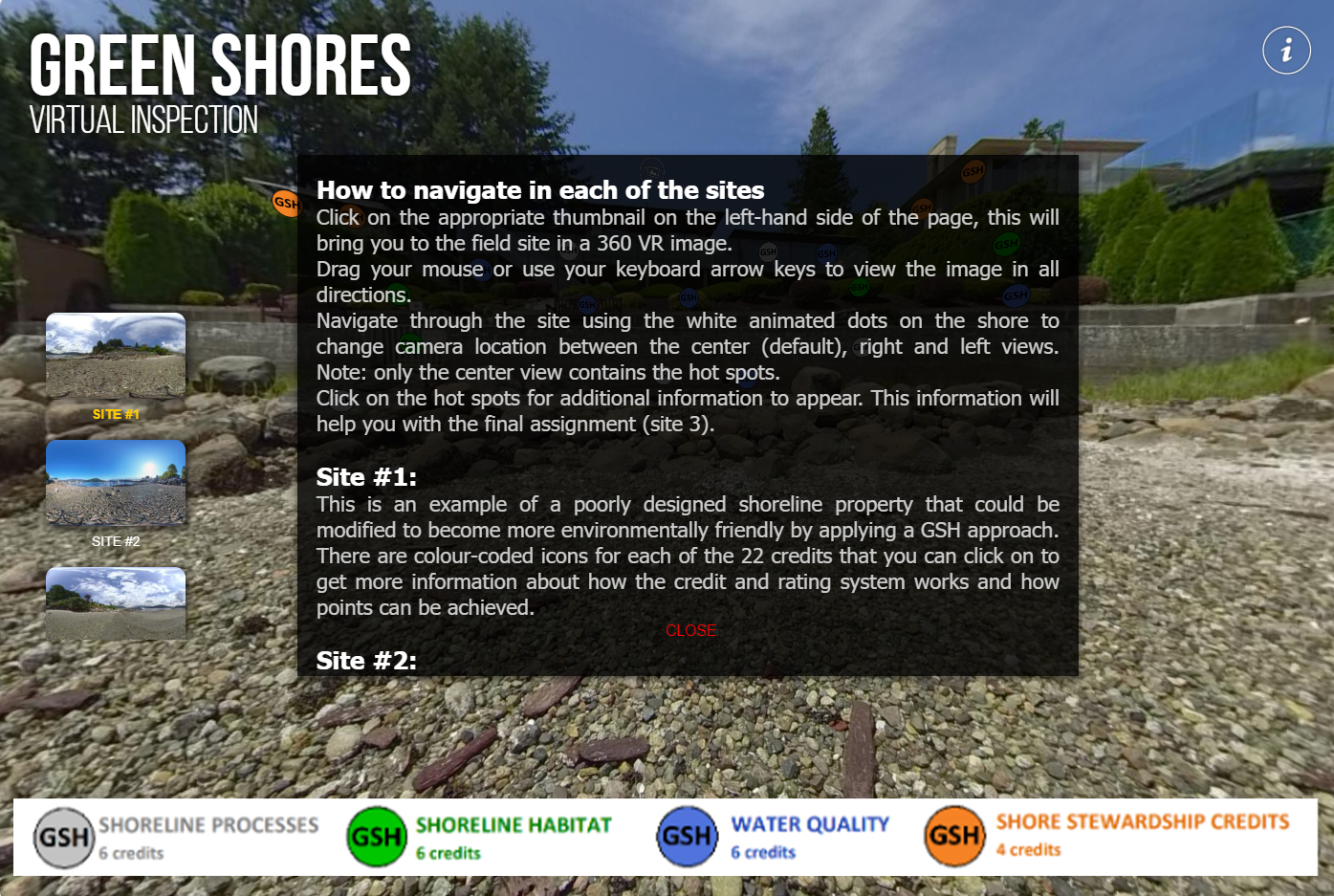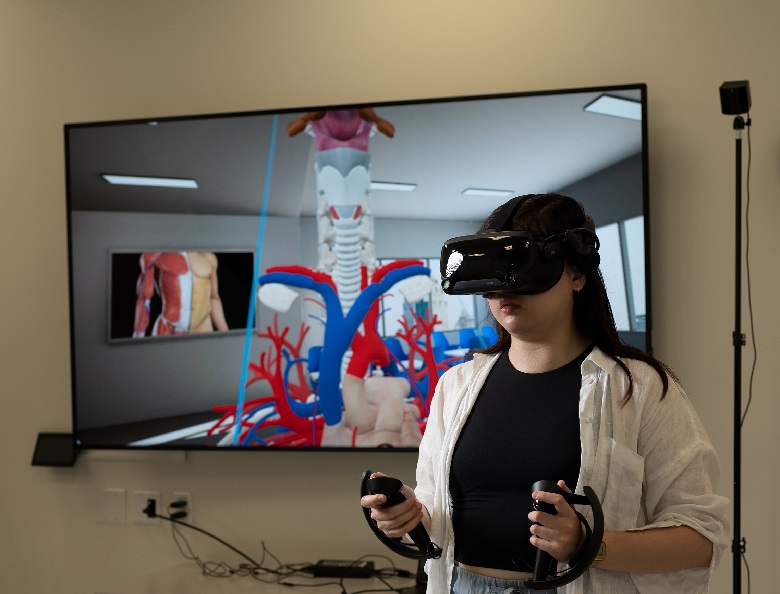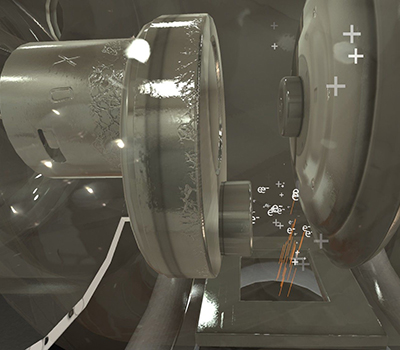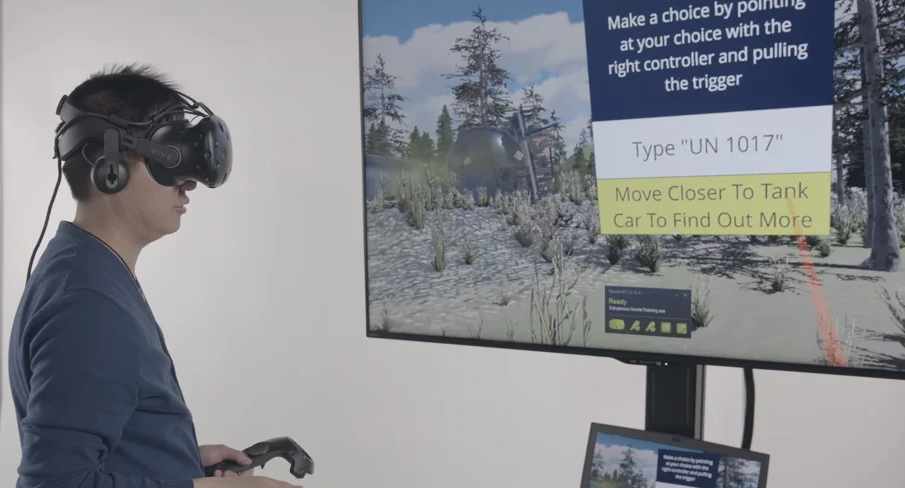Featured Solutions
Augmented and virtual reality allow learners to interact with a three-dimensional image or environment in a way that seems real. We’ve developed a variety of solutions for the classroom, from 3D interactions to augmented reality to virtual reality.
Request: Create a Virtual Fieldtrip
For this 3D design project, our development team (video and instructional design) used the technology to create a solution for David Harper, Program Head for BCIT’s Ecological Restoration program, and Stewardship Centre BC, sponsors of an environmental restoration initiative called Green Shores for Homes (GSH). GSH is a “voluntary, incentive-based rating program [that] helps waterfront homeowners restore natural shorelines … and minimize the environmental impact of waterfront property development.” Owners and property developers can make ecological improvements that earn credits for benefits such as tax incentives, reduced fees, or expedited permits.
Harper had partnered with the Stewardship Centre to create an online version of their training course, which usually involves a one-day outdoor workshop on Vancouver Island. He had previously taken the workshop for his personal PD and recognized it as a valuable tool for his own students; the Stewardship Centre, for their part, wanted to expand their reach off the island and west coast. The complication with creating an online version of such a course is that the valuable hands-on learning component is completely missed, hence the need for it to be interactive. This problem brought Harper to the LTC to explore whether a virtual solution could be developed to replicate the outdoor learning experience.
Solution Requirements
Through discussion, the team identified some key technological and instructional needs for Harper and the Stewardship Centre:
- to replicate a field scenario through something more than photos and videos
- to allow students to identify, observe, and assess the relative position and size/scale of the various shoreline features, the topography, the slope of the property and the surrounding landscape, and site disturbances
- to create a virtual walk along the shoreline that was, most importantly, user-guided and user-friendly
- to design a lesson based on a real-world task where learners manipulate objects, receive feedback, evaluate and interpret physical features, and form new ideas
The Technology Solution
To create this virtual world, we filmed the shoreline scenes with an Insta360 Pro VR camera. We use this technology to take still images or video and wrap them into a sphere that lets people look around in all directions, zero in on hotspots, and jump to different markers in the scene. The camera works by capturing image or video files from six lenses with a 190-degree field of view, and the files are then processed with software that stitches the images into 3D or panorama formats. Hotspots containing photos, 3D images, web links, pdf files, and other components can be added to the scenarios. Shots can also incorporate 3D audio, which wasn’t necessary for this project but has been useful for worksites involving equipment with safety concerns.
The Educational Product
Combining instructional strategies and video technology, the resulting educational product for this request adapted a face-to face class to a virtual environment, replicating an authentic learning experience for students. Not only is Green Shores now a regular part of Harper’s first-year field skills course, but it’s also offered as a BCIT microcredential that’s become popular with learners on the other side of the country, meeting the aim for the Stewardship Centre of BC as well.

Request: Implement 3rd-Party VR Software

Today’s immersive VR tools make it easier for students to visualize the complex systems of skin, blood vessels, muscles, and bones that make up the human body. BCIT’s Medical Radiography program has integrated two different simulation programs into its curriculum—one to help students develop a 3D spatial sense of how organs fit within the body and one to help them learn how to best position a patient to get the ideal X-ray view. The PRISM team provided research, instructional design, and implementation expertise to help faculty integrate the VR experience directly into the curriculum through daily Learning Hub activities.
3D Organon is an anatomy program that allows students to virtually manipulate and examine the organs that make up different body systems. A key aspect of the software is that it allows users to look inside the body from different angles, called “planes,” just as imaging equipment would be positioned from different angles. Users can also cut away sections to view the body in layers.
The second VR software being used is Skilitics, which simulates an X-ray room and the process of taking an X-ray. The software uses an anatomically accurate virtual dummy that learners position on the table. Students can finetune their skills in the simulated environment, which gives them more confidence and a faster learning curve when they move on to a clinical setting.
Request: Find a Better Way to Teach a Complex Topic
Be the Beam is a guided tour experience that shrinks users down and places them inside complicated X-ray machinery. The goal of this tour is to educate learners on the physics of how X-rays are produced by allowing them to witness the creation of X-rays in slow motion, right in front of their eyes. They explore an X-ray room, energize the X-ray beam, and then virtually shrink down and travel inside the X-ray tube to discover the physics behind X-ray generation. This project was completed in 2021 and is now widely used by the Medical Radiography program. During development, Be the Beam received national recognition, with team members winning a 2019 SIM Innovator Award for Educational Innovation.

Request: Teach “Hands-on” Railway Disaster Response
In 2023, 913 rail accidents were reported to the Transport Safety Board of Canada (TSB), including 87 involving dangerous goods. This standalone Unity VR application simulates an accident scene involving a railway train that contains chlorine (UN 1017 transport goods). We designed this application to increase railway knowledge to help future workers respond appropriately to disasters.
The next iteration of this application will simulate how the emergency medical responder in the area will respond to this kind of incident.

Request: Prepare Students for Practice on Real Motor Parts
The automotive department at BCIT has a number of AR/VR simulations that allow learners to practice working with automotive parts on a computer screen. Once learners have mastered the skills virtually, they can move to the workshop and work on an actual motor, where they’re faster and have less chance of breaking an expensive part.
Request: Patient Assessment Simulation
This application allows the learner to interact with a simulated patient using a desktop keyboard, voice commands, or an arrow marker. In this video, the user triggers a seizure in the patient and practices placing an oxygen mask to control the seizure.
Request: To Trigger Emotional Responses to a Scene
The goal of this project is to immerse nursing students in virtual reality simulations aimed at evoking an empathetic response towards patients who are extremely difficult to work with, abusive, or even violent. Nurses’ emotional responses will be monitored before, during, and following these simulations to determine if the simulations have a positive effect on their ability to empathize with difficult patients. With this project, PRISM’s VR development team is using both motion capture and facial capture of professional actors to create realistic body movements and facial expressions in our animations.

